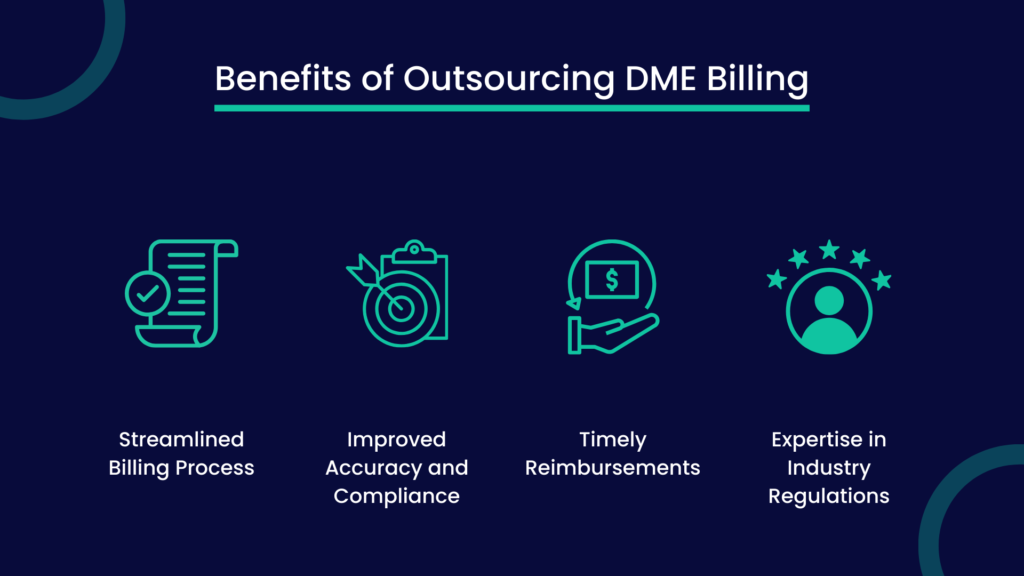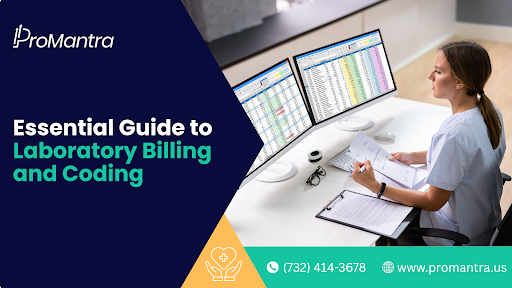LTDR: Why DME Billing Expertise Matters
- Ensures faster patient access to medically necessary equipment
- Improves reimbursement speed and reduces claim denials
- Strengthens compliance with CMS and payer-specific guidelines
- Minimizes revenue loss through accurate billing and documentation
- Supports long-term financial health and operational efficiency in healthcare organizations
Billing for Durable Medical Equipment (DME) is a specialized area within the healthcare sector that focuses on the reimbursement processes associated with the provision of necessary medical equipment to patients. Understanding DME billing is crucial for providers, as it involves navigating complex regulations, coding systems, and insurance policies.
Durable Medical Equipment is also part of a broader category known as DMEPOS (Durable Medical Equipment, Prosthetics, Orthotics, and Supplies). These include:
- DME: Hospital beds, walkers, wheelchairs
- Prosthetics: Artificial limbs
- Orthotics: Braces, neck supports
- Supplies: Glucose strips, infusion pumps
All DMEPOS items must be prescribed, reusable, and serve a medical purpose to qualify for reimbursement.
This guide aims to provide a comprehensive overview of DME in medical billing, including its definitions, key components, challenges, and future trends. By gaining insights into effective billing practices, healthcare organizations can enhance their revenue cycle management and ensure timely reimbursements for the essential equipment they provide to patients.
Struggling to keep up with DME billing complexities? Now is the time to simplify your process before denials pile up.
➤ Talk to a billing expert
What is DME in Medical Billing?
Durable Medical Equipment (DME) refers to medical devices that are designed to withstand repeated use and are primarily used for medical purposes. DME is prescribed by healthcare providers and is necessary for patients’ treatment, rehabilitation, or management of chronic conditions.
The equipment must be suitable for home use and typically includes items such as wheelchairs, oxygen equipment, and hospital beds. Understanding the classification and requirements associated with DME is essential for effective billing and reimbursement processes.
To qualify for reimbursement, Medicare defines DME as equipment that meets the following criteria:
- Can withstand repeated use
- Serves a specific medical purpose
- Is suitable for use in the home
- Is not useful to someone without illness or injury
- Is prescribed by a licensed medical professional
Items used for comfort or general convenience: such as air purifiers, heating pads, or massaging chairs – do not qualify as DME under CMS guidelines.
Pro Tip: DME billing is more than just paperwork. A properly structured process reduces denials, speeds up collections, and ensures compliance with CMS rules.
Also Read: RCM for DME and HME Providers
Common types of DME include:

1. Wheelchairs and Scooters: Mobility devices designed for patients with limited mobility.
- Example HCPCS code: E1130 – Standard wheelchair, detachable arms, desk length, swingaway footrests
2. Oxygen Equipment: Devices used to deliver supplemental oxygen to patients with respiratory conditions.
- Example HCPCS code: E0431 – Portable gaseous oxygen system
3. Hospital Beds: Adjustable beds that provide comfort and support for patients recovering at home.
- Example HCPCS code: E0260 – Semi-electric hospital bed
4. Walkers and Canes: Assistive devices that help patients with balance and mobility.
- Example HCPCS code: E0143 – Folding wheeled walker
5. Continuous Positive Airway Pressure (CPAP) Machines: Devices used for treating sleep apnea by delivering a continuous stream of air.
- Example HCPCS code: E0601 – CPAP device
6. Orthotics and Prosthetics: Items such as neck braces, artificial limbs, or braces used to support or replace a body part.
- Example HCPCS code: L1833 – Knee orthosis, adjustable
7. Diabetic Supplies: Includes glucose monitors, test strips, and insulin infusion pumps.
- Example HCPCS code: A4253 – Blood glucose test strips
8. Infusion Pumps and Supplies: Used for medication delivery in chronic or acute conditions.
- Example HCPCS code: E0781 – External infusion pump
Pro Tip: Including HCPCS codes in documentation early in the intake process helps streamline billing and improves claim accuracy. Reference payer-specific policies for rental vs purchase restrictions.
Role of DME in Patient Care
DME plays a vital role in patient care by enhancing the quality of life for individuals with disabilities or chronic health conditions. By providing necessary equipment, patients can maintain their independence, manage their conditions more effectively, and improve their overall well-being.
For healthcare providers, understanding the intricacies of billing for durable medical equipment is essential to ensure patients receive the equipment they need while also securing appropriate reimbursement for their services.
For example, patients recovering from orthopedic surgeries often require hospital beds, walkers, or braces to aid in rehabilitation at home. Individuals with sleep apnea rely on timely access to CPAP machines to prevent complications. Any delays in insurance verification, authorization, or billing errors can postpone delivery of this critical equipment, directly impacting patient outcomes.
From the provider’s side, seamless coordination between clinical staff and billing teams helps ensure documentation is complete, claims are clean, and patients are supported with minimal administrative burden.
Also Read: Strategies for DME Billing
Key Components of DME Billing
Effective DME billing involves several key components that contribute to accurate reimbursement and compliance with regulations.

1. Accurate Documentation
Accurate documentation is crucial in the DME billing process. Providers must ensure that all relevant information, including patient details, equipment descriptions, and usage instructions, is documented thoroughly. This documentation serves as the foundation for claims submissions and helps in justifying the medical necessity of the equipment.
Physician Orders and Medical Necessity: A physician’s order is necessary for DME billing, as it establishes the medical necessity for the equipment. Providers must obtain clear and detailed orders from physicians, specifying the type of equipment needed and the patient’s condition. This documentation is critical for securing reimbursement and avoiding claim denials.
Proof of Delivery Requirements: Proof of delivery is another essential component of DME billing. Healthcare providers must maintain records that demonstrate the delivery of equipment to the patient, including delivery receipts and signatures. This documentation is vital for ensuring compliance and supporting claims submissions.
Additional documentation often required includes:
- Detailed Written Order (DWO): Specifies the item, duration, diagnosis, and justification signed by the prescribing physician.
- Face-to-Face Encounter Note: For many Medicare claims, a provider must document a patient visit within 6 months of ordering certain DME.
- Advance Beneficiary Notice (ABN): Informs patients they may be financially responsible if the equipment is not covered.
Pro Tip: Always confirm payer-specific requirements for DWOs and face-to-face documentation to avoid denials during audits.
2. HCPCS Coding for DME
Proper coding is integral to DME billing. The Healthcare Common Procedure Coding System (HCPCS) is used to identify and classify DME for billing purposes.
Overview of HCPCS Codes: HCPCS codes are alphanumeric codes that represent specific medical services, procedures, and equipment. They are divided into two levels: Level I codes, which are based on the Current Procedural Terminology (CPT), and Level II codes, which specifically cover non-physician services, including DME.
Examples of Common DME Codes:
- E0900: Wheelchair, manual, standard
- E0424: Stationary oxygen concentrator
- E0260: Hospital bed, semi-electric
Common Modifiers for DME Billing:
- NU – New Equipment
- RR – Rental
- UE – Used Equipment
- KX – Required documentation is on file and meets medical necessity
- GA – Waiver of liability on file (used when ABN is signed)
- GY – Item is statutorily excluded or does not meet Medicare criteria
Using these correctly is critical to claim acceptance and audit compliance.
Missing one form or code can delay an entire claim. Start building a clean, audit-ready workflow today.
➤ Let’s build your ideal billing process
Common Billing Scenarios Using Modifiers
Example 1: Wheelchair Rental Transition to Purchase
- A patient requires a manual wheelchair after surgery.
- Initial claim uses E1130 RR (rental, 3 months)
- After rental period, provider bills E1130 NU (new purchase) with documentation of medical necessity and face-to-face exam.
Example 2: CPAP with KX Documentation
- Patient is diagnosed with sleep apnea and prescribed a CPAP.
- Bill with E0601 NU KX to indicate new equipment and that all documentation is on file (including sleep study results and DWO).
Pro Tip: When billing rentals, always indicate the month and duration using the appropriate date ranges and modifiers. Incorrect or missing modifiers are a common cause of payment delays or rejections.
3. Claims Submission Process
The claims submission process is a critical step in DME billing that requires attention to detail and adherence to guidelines.
CMS 1500 Form: Most DME claims are submitted using the CMS 1500 form, which is the standard claim form used by healthcare providers to bill Medicare and other insurance payers. This form requires detailed information about the patient, provider, and services rendered, including the appropriate HCPCS codes.
Directing Claims to the Right Insurer: Providers must ensure that claims are directed to the correct insurer for reimbursement. This involves verifying patient insurance information and understanding the specific billing requirements of each payer. Incorrect submissions can lead to delays in payment or claim denials.
Most insurers, including Medicare, impose strict timely filing deadlines, typically ranging from 90 days to 1 year from the date of service. Submitting claims electronically (EDI) through clearinghouses ensures quicker delivery and confirmation, improving turnaround time.
Pro Tip: Implement a claims tracking dashboard that flags pending submissions nearing the deadline to prevent missed reimbursements.
4. Ensuring Compliance
Compliance is a critical aspect of DME billing, as providers must adhere to federal and state regulations, as well as payer-specific guidelines.
Adherence to Payer Guidelines: Each insurance payer has unique billing guidelines and requirements that must be followed. Providers should familiarize themselves with these guidelines to ensure compliance and minimize the risk of claim denials.
Staying Updated with Industry Changes: The healthcare landscape is constantly evolving, with regulations and policies frequently changing. Providers must stay informed about industry updates to ensure their DME billing practices remain compliant and effective.
Compliance with DME billing involves not only payer policies but broader legal standards, including:
- HIPAA: Ensuring patient data security in claims processing
- Stark Law: Avoiding self-referrals for DME from physicians with financial interest
- Anti-Kickback Statute: Prohibits incentives for referring DME services
Conducting routine internal audits and ongoing staff training helps identify errors and keep your process aligned with evolving rules.
Pro Tip: Use audit logs and payer portal feedback to spot patterns in denials or flagged claims, and adjust workflows accordingly.
Challenges in Billing for Durable Medical Equipment
Despite its significance, billing for durable medical equipment comes with several challenges.
- Complex Reimbursement Policies: DME reimbursement policies can be complex and vary significantly between payers. Understanding these policies is essential for ensuring accurate billing and avoiding claim denials.
- Frequent Claim Denials: Claim denials are a common challenge in DME billing, often resulting from incorrect coding, insufficient documentation, or failure to meet medical necessity requirements. Providers must implement effective denial management strategies to address these issues.
- Audit Risks and Compliance Issues: DME billing is subject to audits, which can result in compliance issues if documentation is inadequate or incorrect. Providers must maintain thorough records and adhere to best practices to mitigate audit risks.
Audit Triggers and How to Prepare
Durable Medical Equipment billing is often subject to post-payment audits, especially by Medicare. These reviews verify that providers followed proper documentation and billing practices.
Here are the most common audit types in DME billing:
- CERT (Comprehensive Error Rate Testing): Random post-payment reviews
- RAC (Recovery Audit Contractor): Identifies and recoups overpayments
- MAC (Medicare Administrative Contractor): Performs pre- and post-pay audits
- UPIC (Unified Program Integrity Contractor): Investigates potential fraud or waste
Top Audit Triggers to Watch For
- Billing expensive items repeatedly (e.g., power wheelchairs, oxygen systems)
- Submitting claims without required documentation (DWO, face-to-face)
- Inconsistent use of modifiers
- Excessive rental durations beyond medical necessity
- Missing proof of delivery or physician signature
How to Prepare for a DME Audit
- Maintain a centralized audit binder (physical or digital) with key documents
- Ensure face-to-face visit notes and DWOs are signed and date-matched
- Keep delivery receipts and ABNs easily retrievable
- Set up an internal monthly review of high-value or frequently denied claims
- Store all DME billing documentation for at least 7 years, as required by Medicare
Pro Tip: Conduct mock audits quarterly to identify and resolve issues before a payer flags them. Use payer portals (like CGS or Noridian) to monitor audit trends and updates.
Benefits of Outsourcing DME Billing
Outsourcing DME billing can offer numerous advantages for healthcare providers.

- Streamlined Billing Process: Outsourcing allows providers to streamline their billing processes, enabling them to focus on patient care while experienced billing professionals handle the complexities of DME billing.
- Improved Accuracy and Compliance: Billing service providers specializing in DME can enhance accuracy and compliance, reducing the likelihood of claim denials and ensuring adherence to regulations.
- Timely Reimbursements: Outsourcing DME billing can lead to faster claims processing and timely reimbursements, improving the overall cash flow for healthcare organizations.
- Expertise in Industry Regulations: Billing service providers possess in-depth knowledge of industry regulations and payer requirements, ensuring that DME billing practices remain compliant and effective.
Payer-Specific Considerations in DME Billing
DME billing is not one-size-fits-all. Reimbursement rules, documentation needs, and coding policies often differ by payer.
Key Variations Across Payers
- Medicare:
- Requires face-to-face exams for many items
- Enforces strict rules on rental vs purchase timelines
- Audits are frequent; all claims must follow LCD/NCD criteria
- Requires electronic claims submission unless exempt
- Requires face-to-face exams for many items
- Medicaid (State-Specific):
- May follow Medicare rules but include additional PA forms or frequency limits
- Reimbursement rates vary significantly by state
- May follow Medicare rules but include additional PA forms or frequency limits
- Commercial Insurance:
- May require prior authorization for most DME, even basic items
- Typically has shorter filing deadlines (e.g., 90–180 days)
- Modifiers may differ in acceptability; KX and GA not always used
- May require prior authorization for most DME, even basic items
Tips for Navigating Payer Differences
- Keep a payer billing guide or quick-reference sheet for your top 5 insurers
- Subscribe to payer newsletters for policy change alerts
- Call and verify authorization and documentation requirements before billing high-dollar DME
Pro Tip: Always use payer-specific portals (like Availity, Noridian, or DME MAC sites) to confirm current billing instructions before claim submission.
Choosing a DME Billing Partner
When selecting a DME billing partner, healthcare providers should consider several key features.

- Experience in DME Billing: Look for a provider with a proven track record in DME billing and a deep understanding of the complexities involved.
- Advanced Technology: Ensure the billing partner utilizes advanced billing software and automation for efficient claims processing and reporting.
- Robust Compliance Measures: The billing partner should have strong compliance measures in place to mitigate audit risks and ensure adherence to regulations.
- Excellent Customer Service: Effective communication and support are essential for a successful partnership, so choose a provider that values customer service.
Promantra: Your Ideal DME Billing Partner
Promantra offers comprehensive DME billing services tailored to meet the unique needs of healthcare providers. With a team of experienced professionals and advanced technology, Promantra ensures accurate billing for durable medical equipment, timely reimbursements, and compliance with industry regulations.
By partnering with Promantra, healthcare organizations can streamline their billing processes, reduce claim denials, and focus on delivering quality patient care. Book a meeting with our team today to ensure a stress-free RCM and medical billing experience.
Also Read: Outsourcing DME Billing
Future Trends in DME Billing
The future of DME billing is likely to be shaped by various trends influenced by technology and regulatory changes.
- Impact of Technology on DME Billing: The integration of technology into DME billing processes is expected to enhance efficiency and accuracy. Advanced billing software solutions can automate many aspects of the billing process, reducing the risk of human error and improving overall performance.
- Automation in Claims Submission: Automation in claims submission will streamline workflows and expedite reimbursement processes. Automated systems can facilitate real-time claims tracking and reporting, allowing providers to monitor their billing performance effectively.
- Adapting to Changing Regulations: As the healthcare landscape evolves, DME billing practices must adapt to changing regulations and payer requirements. Staying informed about these changes will be essential for providers to maintain compliance and optimize their reimbursement processes.
Conclusion
Understanding DME billing is essential for healthcare providers to effectively manage the reimbursement process for durable medical equipment. By familiarizing themselves with key components, challenges, and best practices in billing for durable medical equipment, providers can enhance their revenue cycle management and ensure timely payments.
Outsourcing DME billing to experienced partners like Promantra can further streamline the process, improve accuracy, and allow healthcare organizations to focus on delivering quality care to their patients. As the industry continues to evolve, staying informed about trends and technology will be vital for success in DME billing.
Promantra’s DME Billing services provide healthcare providers with a comprehensive solution for accurate and efficient billing of durable medical equipment. By leveraging their expertise and advanced technology, Promantra ensures that every claim is meticulously processed, minimizing errors that can lead to denials. This focus on precision allows providers to secure timely reimbursements and optimize their revenue cycle.
Outsourcing DME billing to Promantra not only alleviates administrative burdens but also enhances compliance with industry regulations. With a dedicated team that stays updated on payer requirements, providers can trust Promantra to improve their billing accuracy and ultimately collect more from insurance, allowing them to concentrate on patient care.
Don’t wait for denials or delays to take a toll. Promantra is ready to support your next step forward in DME billing.
➤ Book a consultation




